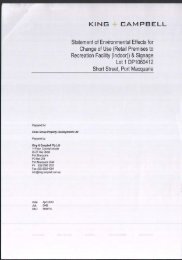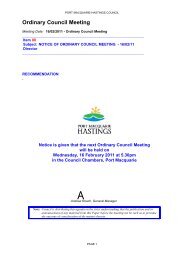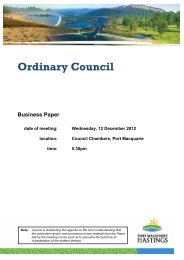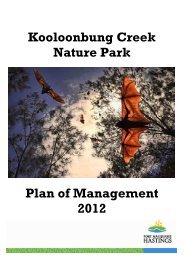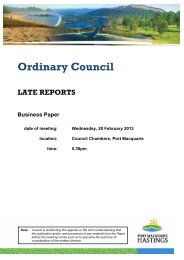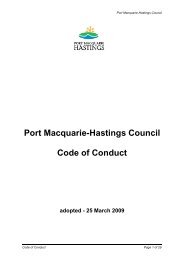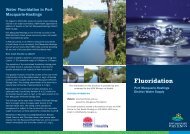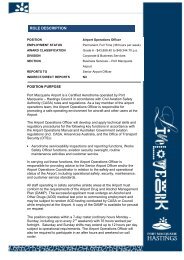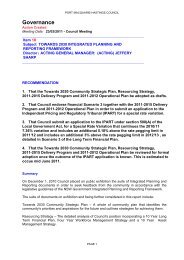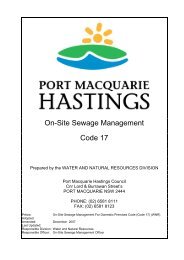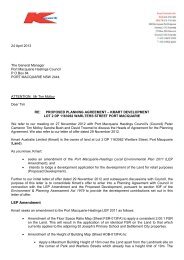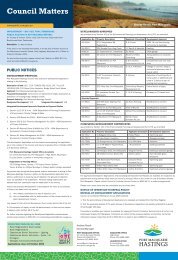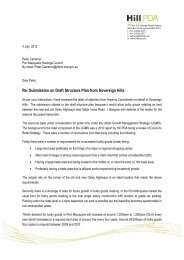Water Engineering Australia July 2009 Cover Story.pdf - Hastings ...
Water Engineering Australia July 2009 Cover Story.pdf - Hastings ...
Water Engineering Australia July 2009 Cover Story.pdf - Hastings ...
You also want an ePaper? Increase the reach of your titles
YUMPU automatically turns print PDFs into web optimized ePapers that Google loves.
COVER<br />
Improving<br />
water quality<br />
on NSW’s mid<br />
north coast<br />
A $25 million investment by Port Macquarie-<strong>Hastings</strong> Council to improve the<br />
quality of its drinking water has been recognised by Engineers <strong>Australia</strong>’s Newcastle<br />
Division for its engineering excellence.<br />
16 WATER ENGINEERING AUSTRALIA JULY <strong>2009</strong>
WATER TREATMENT<br />
The Wauchope <strong>Water</strong> Treatment Plant<br />
(WTP) Project has been recognised with<br />
two prestigious awards at the Engineers<br />
<strong>Australia</strong> Newcastle Division’s <strong>2009</strong> <strong>Engineering</strong><br />
Excellence Awards.<br />
Commissioned in 2008, the project won an<br />
overall award for Excellence, placing it in the<br />
running for the national Excellence Awards at<br />
the end of the year. It also received the Award for<br />
Innovation in Sustainable <strong>Engineering</strong> Excellence.<br />
The plant, which is near Port Macquarie on the<br />
NSW mid north coast, is a $25 million investment<br />
by Port Macquarie-<strong>Hastings</strong> Council to<br />
improve the drinking water quality for all consumers<br />
and to better achieve the quality standards<br />
set by the <strong>Australia</strong>n Drinking <strong>Water</strong> Guidelines.<br />
The plant fi lters the drinking water for the<br />
Wauchope water supply scheme, west of Port<br />
Macquarie, which includes the Wauchope,<br />
Beechwood, King Creek and Sancrox areas. <strong>Water</strong><br />
conditioning facilities within the plant also help<br />
to increase the alkalinity and stabilise the pH<br />
of all water pumped from the <strong>Hastings</strong> River at Koree Island,<br />
before it is stored in the Port Macquarie and Cowarra off-creek<br />
storage dams.<br />
The site at Quarry Road includes a treatment plant building,<br />
a 5ML clear water reservoir, a clear water pumping station and<br />
educational facilities to further enhance Council’s <strong>Water</strong>Wise<br />
education and community awareness programmes.<br />
The filtration plant has a daily water treatment capacity of<br />
6ML, with the ability for future upgrade to 18ML/d. The water<br />
conditioning facilities are able to treat 120ML/d.<br />
The main players<br />
The project’s construction was managed by the NSW Department<br />
of Commerce; the NSW Government Architect’s Office designed<br />
the building and educational facilities; Reed Constructions<br />
<strong>Australia</strong> was the constructor; Veolia <strong>Water</strong> Systems installed<br />
the ultra-filtration membrane process, electrical and mechanical<br />
equipment; <strong>Water</strong> Treatment <strong>Australia</strong> installed the lime and<br />
carbon dioxide dosing equipment; and the NSW Department<br />
of <strong>Water</strong> & Energy was a funding partner under the Country<br />
Towns <strong>Water</strong> Supply and Sewerage Subsidy Scheme.<br />
As for subcontractors, Coffey Geotechnics was the geotechnical<br />
engineer; Jung Constructions Pty Ltd provided concrete construction<br />
works; Brian Mansfield Plumbing were consulted for building<br />
hydraulic services; Oxley Air Conditioning Services provided<br />
ventilation and air conditioning services; Eire Contractors were<br />
consulted for the water pipeline construction; Mid Coast Telemetry<br />
performed electrical installation works; HERC Equipment<br />
did metal fabrication and installation works; and Gean Custom<br />
Marine worked on the lime silo steel protective shell.<br />
The council’s water supply, electrical, mechanical and telemetry<br />
staff were also involved in investigation, design and construction.<br />
Origins of the project<br />
The project was prompted by the release of the draft National<br />
Health and Medical Research Council’s (NHMRC) <strong>Australia</strong><br />
Drinking <strong>Water</strong> Guidelines in 1994. In the council’s subsequent<br />
review of its drinking water quality compliance and water<br />
The membrane modules for the treatment plant.<br />
treatment processes, two major drinking water quality issues<br />
were identified.<br />
Firstly, the level of water treatment provided at existing river<br />
water sources needed to be improved. In particular, local communities<br />
at Wauchope and three rural villages had no effective<br />
protection from parasite contamination such as giardia and<br />
cryptosporidium.<br />
Secondly, there was the need to provide water conditioning<br />
to overcome the natural “softness” or low alkalinity and calcium<br />
levels, of the river water obtained from the <strong>Hastings</strong> River at<br />
Koree Island. This soft water was found to be potentially corrosive<br />
to water supply infrastructure including; pumps, pipes,<br />
concrete reservoirs and plumbing fi xtures. Evidence of this<br />
long-term corrosion of water supply infrastructure had previously<br />
been identified through asset performance monitoring and asset<br />
management investigations.<br />
The effectiveness of the existing chlorination disinfection<br />
process would be improved due to the increased “buffering”<br />
capacity or the ability to resist changes in pH value, of the<br />
conditioned water. Less sodium hypochlorite would need to be<br />
dosed to achieve “breakpoint” chlorination and disinfection of<br />
the drinking water. This would also reduce consumer complaints<br />
regarding chlorine smell and tastes in the drinking water due to<br />
the improved chemistry of the drinking water.<br />
In addition it was highlighted that the conditioned water would<br />
provide more favourable and stable water quality parameters in<br />
the council’s off-creek storage dams.<br />
In locating the water conditioning facilities at the Wauchope<br />
WTP, it would be possible to condition all the water pumped<br />
from the <strong>Hastings</strong> River prior to it being transferred and stored<br />
in the off-creek storage dams.<br />
With further consideration of the adopted NHMRC <strong>Australia</strong>n<br />
Drinking <strong>Water</strong> Guidelines in 1996, it was determined that<br />
additional water treatment processes were needed.<br />
Membrane filtration preferred<br />
The council conducted site visits to existing water treatment<br />
plants in New South Wales, Queensland and Victoria were<br />
WATER ENGINEERING AUSTRALIA JULY <strong>2009</strong><br />
17
WATER TREATMENT<br />
Submerged membrane filtration became the preferred treatment option for the water treatment plant, shown here, as it did not<br />
require the addition of further chemicals to achieve the drinking water quality targets.<br />
undertaken with the assistance of the NSW Department of<br />
Commerce and Hunter <strong>Water</strong> <strong>Australia</strong> to investigate currently<br />
available and merging water treatment technologies. This included<br />
water conditioning plants, as low alkalinity water is a<br />
common feature of many river water supplies sources in NSW<br />
and Victoria.<br />
Submerged membrane filtration was selected as the preferred<br />
treatment option, as it did not require the addition of further<br />
chemicals to achieve the drinking water quality targets. This<br />
treatment option also provided significantly lower energy requirements<br />
and future operating costs.<br />
The membranes are tiny hollow fibres with miniscule holes<br />
(0.04 micron), which allow water molecules to pass through,<br />
but do not allow any sediment or contaminants through the<br />
membrane fibres. Nearly 10,000 of these fibres are bundled<br />
together to form a module unit and each module provides 34m 2<br />
of filtration surface area.<br />
“It is pleasing to note that this ultra-fi ltration membrane<br />
technology has been developed and manufactured by Memcor<br />
<strong>Australia</strong> at the company’s factory and research facilities based<br />
in Windsor just west of Sydney,” said Port Macquarie-<strong>Hastings</strong><br />
Council’s water supply manager Murray Thompson.<br />
The membrane module racks are located inside a membrane<br />
tank and submerged in the raw water which is fed into the tank<br />
during the filtration process, which involves a suction pressure<br />
being applied to the inside of the hollow fibres. Clear water is<br />
then drawn through the fibres with contaminants remaining on<br />
the outside of the fibres and inside the tank.<br />
The water conditioning included the addition of hydrated<br />
lime to the raw water pumped from the river to raise calcium<br />
and alkalinity levels and then post pH correction dosing with<br />
carbon dioxide gas to stabilise the pH in the water.<br />
Operation of the plant<br />
The operation of the Wauchope WTP involves the conditioning<br />
of all water pumped from the <strong>Hastings</strong> River and then the<br />
subsequent filtration of drinking water supplied to consumers<br />
in the Wauchope area.<br />
Council operates three pumping stations on the <strong>Hastings</strong><br />
River at Koree Island. The three rising mains from these pumping<br />
stations pass through the WTP site allowing for the water<br />
“conditioning” process to be competed via the injection of lime<br />
slurry and CO 2<br />
gas into each rising main. The conditioned water<br />
is then stored in the Rosewood Reservoirs, before being transferred<br />
to the council’s two off-creek storage dams.<br />
A portion of this conditioned water is returned to the Wauchope<br />
WTP via a separate pipeline from the Rosewood Reservoirs<br />
for filtration before it is supplied to consumers in the Wauchope<br />
area.The operation of the membrane filtration plant involves the<br />
18 WATER ENGINEERING AUSTRALIA JULY <strong>2009</strong>
WATER TREATMENT<br />
WTP clear water reservoir “calling” for water; the “conditioned”<br />
water is then delivered by gravity flow from the Rosewood raw<br />
water reservoir into the membrane tank via an automatic self fl<br />
ushing Thompson Filter Screen which removes any debris, which<br />
may damage the membranes.<br />
This conditioned water has been dosed with sodium hypochlorite<br />
solution (known as hypo), which provides disinfection for the<br />
water. This hypo dosing process also precipitates dissolved iron<br />
and manganese in the raw river water and helps to discourage<br />
algal growth on the membranes.<br />
The water then enters the membrane tank and is drawn through<br />
the membranes by suction pressure applied using the filtrate/<br />
backwash pump units. The membrane tank contains 192 membrane<br />
modules. Impurities and contaminants in the water are<br />
trapped on the outside of the membrane fibres, while the filtered<br />
or “clear water” is drawn through the hollow membrane fibres<br />
and into a clear water reservoir ready for transfer to the Rosewood<br />
clear water reservoir and onto consumers in the Wauchope area.<br />
Monitoring and control<br />
The water treatment plant is automatically monitored and controlled<br />
by an intelligent Programmable Logic Control (PLC)<br />
programme. This PLC system provides a user friendly and cost<br />
effective control system, which includes an Operator Machine<br />
Interface (OMI) screen to allow plant operations to be visually<br />
displayed and monitored easily by water staff.<br />
The information monitored by the PLC system including<br />
reservoir levels, plant flow rate and water quality, river water<br />
quality parameters together with warning and shutdown alarms<br />
are sent via Council’s Telemetry network to the Council’s offi ces<br />
and other operational sites to allow remote monitoring.<br />
A standby SCADA Control Centre has been established at<br />
The tank farm for the plant. The far tank is the backwash<br />
pumping station.<br />
Aboriginal artworks at the site recognise the <strong>Hastings</strong><br />
River as the source of the water supply for the area. They<br />
depict animals and fish found within the local aquatic<br />
environment.<br />
the Wauchope WTP to act as an alternative emergency site if<br />
problems occur with Council’s main<br />
<strong>Water</strong> Supply SCADA and Operations Control Centre, which<br />
is located in Port Macquarie. A standby generator and UPS system<br />
installed at the Wauchope WTP ensure that this control centre<br />
can continue to function during emergency situations.<br />
A local optic fibre network is currently being established to<br />
provide secure data transfer between all water supply sites in<br />
this area including the Koree Island River Pumping Stations,<br />
Koree Island High Voltage Substation, <strong>Hastings</strong> River CCTV<br />
Monitoring System, Koree Island River Flow and <strong>Water</strong> Quality<br />
Monitoring Station, Rosewood Reservoirs, Rosewood Fluoridation<br />
Plant and Rosewood Telemetry Repeater Station.<br />
A high speed microwave link between the Wauchope WTP<br />
and Transit Hill Reservoir Communications Tower in Port Macquarie,<br />
will allow all of this operational data to be monitored and<br />
controlled from Council’s <strong>Water</strong> Supply SCADA and Operations<br />
Centre. Due to the effectiveness of the monitoring and control<br />
system, problems can be easily identified, diagnosed and rectified<br />
remotely, with operator attendance only required during normal<br />
working hours.<br />
Cleaning the filters<br />
From an operational point of view, as the submerged membranes<br />
are a physical barrier to contaminants, the quality of water<br />
produced is constant regardless of feed water quality. However,<br />
raw water quality parameters such as turbidity, pH, temperature<br />
and nutrient levels are continually assessed to ensure compliance<br />
with the treatment plant and dam filling operating rules.<br />
When turbidity and/or nutrient levels in the river are above<br />
acceptable limits, the treatment plant automatically enters a<br />
WATER ENGINEERING AUSTRALIA JULY <strong>2009</strong><br />
19
WATER TREATMENT<br />
River Dirty mode. During this mode the filling of the council’s<br />
off-creek storage dams is suspended to prevent dirty and high<br />
nutrient water from contaminating the dams, which could promote<br />
excessive and undesirable algal growth within the dams.<br />
In the River Dirty mode, the river pumping stations continue<br />
to operate in a reduced manner to only feed water into the<br />
treatment plant for filtration in order to supply water to the<br />
Wauchope area. Should river water quality deteriorate further<br />
due to in extremely high turbidity levels or other water quality<br />
problems such as eg toxic algae outbreaks, it is then possible to<br />
backfeed water from the Port Macquarie off-creek storage dam<br />
to maintain an adequate water supply to the Wauchope area.<br />
The membranes are able to treat very high turbidity water<br />
however this will shorten their lifespan and increases the required<br />
frequency of cleaning. The membranes have two methods for<br />
cleaning – backwashing (every 30-40 minutes) and clean in place<br />
(CIP) chemical cleaning (typically every 600 hours of operating)<br />
using citric acid and concentrated sodium hypochlorite.<br />
Backwashing aims to remove sediment particles that have been<br />
drawn onto the membranes during the filtration process. These<br />
sediments gradually clog the pores in the membranes and reduce<br />
the efficiency of the filtration process, which is continuously<br />
monitored using a trans-membrane pressure differential system.<br />
During a backwash cycle, filtration is ceased and a series of<br />
pneumatically operated valves close to ensure no backwash water<br />
enters the clearwater tank.<br />
Low pressure air is delivered at the base of the membrane<br />
modules to agitate the membrane fi bres. Clearwater is also<br />
pumped back into the membranes in the reverse direction to<br />
normal filtration. These processes dislodge and free solids that<br />
have attached themselves to the membrane fibres.<br />
Backwashing of the membranes is undertaken automatically<br />
every 30-40 minutes of plant run time. Large amount of sediment<br />
particles are collected on the membranes even in a short<br />
time period.<br />
The backwash water is then directed by automatic valve operation<br />
into the backwash pumping station; the backwash water is<br />
then pumped into a clarifier and dosed with a small amount of<br />
coagulant to ensure the settlement of solids in the clarifier unit.<br />
The clear water outflow from the clarifier is collected in the<br />
supernatant pumping station and returned to the membrane tank<br />
during normal filtration operation. This backwash water recovery<br />
system is able to achieve a 98% recovery rate. The small amount<br />
of backwash solids collected in the clarifier are discharged into<br />
the sewerage pumping station and transferred to the Wauchope<br />
Sewerage Treatment Plant (STP).<br />
These backwash solids, which include a small amount of<br />
residual coagulant, have seen an improvement in the settling<br />
characteristics of the activated sludge treatment process at the<br />
Wauchope STP. So this additional waste stream has actually<br />
improved the overall performance of the STP.<br />
The clean in place (CIP) chemical cleaning process principally<br />
removes inorganics including metals that have attach themselves<br />
to the membranes and are not removed by the regular backwashes.<br />
This CIP process is completed after every 600 hours of operation.<br />
The continuously monitored Trans-membrane Pressure<br />
(TMP) can also determine the need for a CIP. The TMP is the<br />
differential pressure between the inside and outside of the membrane<br />
fibres during normal filtration. The TMP increases as the<br />
pores in the membranes become progressively more clogged.<br />
CIP cleans are completed using citric acid and concentrated<br />
sodium hypochlorite on an alternating basis as organics are more<br />
susceptible to sodium hypochlorite while the citric acid is more<br />
effective in removing in-organics and metal deposits.<br />
The CIP process is completed using warm water supplied from<br />
an on-site water heater, as this is more conductive to the cleaning<br />
process and concentration levels of the cleaning solution are<br />
more easily maintained.<br />
The CIP process consists of four soak and four recirculation<br />
periods, each 15 minutes long. The sodium hypochlorite or citric<br />
acid is dosed into the warm water via a dedicated automatic dosing<br />
system controlled by the PLC programme. The membranes<br />
soak in the solution for 15 minutes to allow penetration into<br />
hard-to remove build-ups. The solution is then recirculated<br />
through the membranes to allow the internals of the membranes<br />
to be cleaned. This process is repeated with air blower agitation<br />
of the membranes during recirculation for additional cleaning<br />
power.<br />
The membrane tank has been specifically designed to minimise<br />
the wet volume of the tank to reduce regular backwash water<br />
volume and also the CIP wastewater stream. As such only 8<br />
kilolitres of CIP wastewater is produced from each cleaning cycle.<br />
20 WATER ENGINEERING AUSTRALIA JULY <strong>2009</strong>
WATER TREATMENT<br />
These are the filtrate suction/backwash pumps for the plant’s membrane tank.<br />
Wastewater from both the citric acid and concentrated sodium<br />
hypochlorite CIP processes is directed into the Chemical Neutralisation<br />
Tank where it is neutralised and pH corrected before<br />
discharge into the Sewerage Pumping Station.<br />
Initially it had been planned to use sulphuric acid as the acid<br />
for CIP cleans but due to the raw water chemistry is was found<br />
that citric acid would produce better cleaning results and is a far<br />
less dangerous and a relatively harmless product to work with<br />
for both operational staff and the environment.<br />
The operation of the water “conditioning” plant involves<br />
the dosing of lime slurry and CO 2<br />
gas into each of the three<br />
rising mains from the Koree Island Pumping Stations as water<br />
is pumped passed the Wauchope WTP from the river into the<br />
Rosewood Reservoirs.<br />
A 80t lime silo and 60t CO 2<br />
storage vessel provide approximately<br />
three months supply of lime and CO 2<br />
when the “water<br />
conditioning” plant is operating at full capacity of 120ML/day.<br />
The hydrated lime is added to water in a batch feed arrangement<br />
to produce a lime slurry, which is then injected into the<br />
three individual rising mains pumping water from the river to<br />
the Rosewood reservoirs.<br />
A separate above ground lime dosing building has been installed<br />
to provide safe access for staff to operate and maintain the<br />
lime dosing and rising main injection systems. Staff are now able<br />
to easily gain access to this equipment utilising a platform and<br />
overhead gantry crane installed above the rising mains, which<br />
pass through the lime dosing building.<br />
A problem identified during the early stages of the plant’s design<br />
was that operators at other existing plants were required to<br />
often enter deep and confined pits in order to gain access to this<br />
equipment and the dosing lines which require regular removal,<br />
cleaning and maintenance. It was therefore decided to reduce<br />
the workplace risks associated with this regular work activity by<br />
providing an appropriately designed lime dosing building.<br />
In addition the lime dosing building was utilised to house both<br />
static and mechanical mixers which were installed in the rising<br />
mains to ensure the adequate mixing of the lime slurry prior to<br />
pH stabilisation with CO 2<br />
gas injection further downstream in<br />
the each rising main. ●<br />
This article is an edited version of a submission by Port Macquarie-<strong>Hastings</strong><br />
Council for the Engineers <strong>Australia</strong> Newcastle Division's Excellence Awards.<br />
WATER ENGINEERING AUSTRALIA JULY <strong>2009</strong><br />
21



